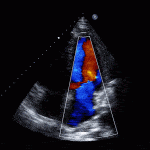Introduction
- Are vegetations that develops from fibrous blood clots and platelet aggregation that are not the result of bacteria.
- They are likely the result of a number of factors including immune complexes, hypoxia, hypercoagulable state, and carcinomatosis.
- This is increasingly being recognized as a disease and if often associated with other systemic diseases including cancers and autoimmune diseases.
- Need to rule out active infection by doing blood cultures.
Associations
- Prior infective endocarditis with now sterile lesions and damaged valve.
- SLE (Systemic Lupus Erythematosous) specific form is Libman-Sacks.
- Rheumatic Fever.
- Hypercoaguable states.
- Antiphospholipid antibody syndrome.
- Can be associated with malignant cancers. Mucin producing Adenocarcinomas of the lung or gut are often associated with NBTE and many hematological malignancies are associated especially if concomitant disseminated intrasvascular coagulation (DIC).
Clinical Features
- “Triad”
- 1) Disease associated with NBTE.
- 2) Heart murmur (though frequently absent).
- 3) Evidence of multiple emboli.
- Recurrent emboli is seen in up to 50% of people with the disease and should be considered a telltale sign of the disease especially in the context of autoimmune disease or associated malignancies.
Diagnosis
- Lab Tests
- Blood cultures to rule out infective endocarditis.
- Coagulation studies, important to rule-out DIC.
- Autoimmune work-up in particular antiphospholipid work-up if recurrent emboli.
- Echo
- NBTE vegetations are small (less than 1 cm), irregular, and broad based.
- Typically effect left sided valves, mitral being the most common.
- Transthoracic (TTE) may not be sensitive enough for diagnosis.
- Given how small the vegetations are transesophageal echo (TEE) is often needed for diagnosis.
- MRI
- Is an emerging technology that may help with diagnosis of NBTE on valves.
- Diffusion weighted imaging (DWI) has also been used to help identify strokes related to infective endocarditis vs NBTE.
Case 1 (Libman-Sacks)
Treatment
- Treat underlying cause such as autoimmune disease or malignancy.
- Correct any coagulopathy issue.
- Generally, if no contraindication anticoagulation should be given to these patients.
References
Sanjay Asopa et al. Non-bacterial thrombotic endocarditis, European Journal of Cardio-Thoracic Surgery, Volume 32, Issue 5, November 2007, Pages 696–701









